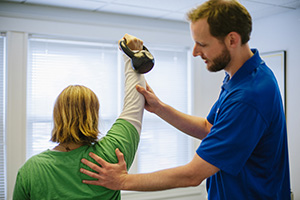Rehab/Corrective Exercise
“But it hurts HERE!”

The exercises are very simple and straightforward and the majority of times require no equipment at all.
When we experience pain or injury, we often believe that the area that hurts the most, is where the problem lies. And the common medical model for treatment is to “fix” the injured area. For instance, if a patient presents with low back pain the common treatment approach is to take pain medications or muscle relaxants to reduce the pain. This only “covers up the symptoms” until the next episode occurs. Pain is our bodies way of telling us that something is wrong. If you had a fire alarm going off in your house, would you just take the batteries out to get it to stop? No, of course not. You would get out of the house and try and figure out why the alarm is going off. So, why when our bodies are “sounding the alarm” do we try to silence it with pain meds? Shouldn’t we try and figure out what the real problem is?
More than meets the eye:
The human body is an extremely complicated system. One which requires all of its parts to function together, in order for the entire system to work properly. If one part is out of balance, (due to acute or cumulative processes), the body will try to protect itself from pain or injury by developing compensatory patterns. These compensations lead to increased stress and strain on areas of the body that may not be designed to absorb them; thereby leading to pain or injury. This is why it’s often possible that a person’s knee pain is actually coming from a loss of range of motion in the hip or ankle, and not a problem with the knee.

Assessments are the first step:
Every individual is different. Different lifestyles and activities cause different compensations and imbalances to occur. This is why it is crucial that everyone go through a thorough evaluation to determine what their specific problem areas may be. There are several assessments that are done by rehab specialists ( such as Dr. Oliver) in order to determine the best treatment plan. One such assessment is the “Selective Functional Movement Assessment” (SFMA). This is a movement based assessment comprised of 7 basic movements which help determine if all areas of the body are moving properly.
Specific exercises:
Once the patient undergoes an assessment Dr. Oliver can provide specific exercises to correct the areas that may be causing problems. Also, Dr. Oliver can determine which exercises/activities to avoid because they may be contributing to these problems. The exercises are very simple and straightforward and the majority of times require no equipment at all. You will be given a very detailed and specific instruction on how to perform these exercises so they can also be performed at home. As a patient works on these exercises they are constantly reassessed to ensure progress is being made. By incorporating these exercises patients are better able to take control of their health and prevent future episodes of pain. This also makes patients less dependent on receiving in-office care – a -win win!
